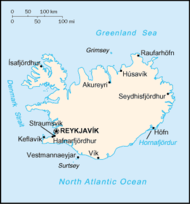


The history of Christianity in Iceland can be traced back to the Early Middle Ages when Irish hermits settled in Iceland, at least a century before the arrival of the first Norse settlers in the 870s. Christianity started to spread among the Icelanders at the end of the 10th century. The adoption of the new faith by the whole population was the consequence of a compromise between the Christian and heathen chieftains, as well as the lawspeaker, at the national assembly or Alþingi of 999 or 1000.
Initially missionary bishops and priests of foreign origin composed the clergy, but the number of local priests quickly increased. The first Icelandic bishop, Ísleifur Gissurarson was consecrated in 1056. Within fifty years two dioceses were established in the island, with their seats at Skálholt and Hólar which were subordinated to foreign archbishops. Landowners had a preeminent role in the administration of Church affairs and earned significant income from the tithe after it was introduced in 1097. Legislation limited the bishops' authority until the end of the Commonwealth in 1264. The principle of the autonomy of the Church only prevailed at the middle of the 14th century. Monasteries, most of them established in the 12th and 13th centuries, became important centers of literature.
The Lutheran form of the Reformation which was introduced in Iceland between 1541 and 1551 caused fundamental changes in Church life, spirituality and culture. For instance, the bulk of Church estates was confiscated and the cult of saints was abolished. The first Icelandic translation of the New Testament was published in 1540, and of the whole Bible in 1584.